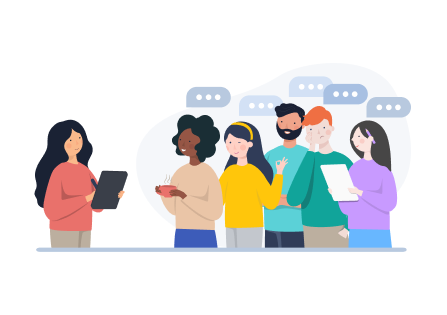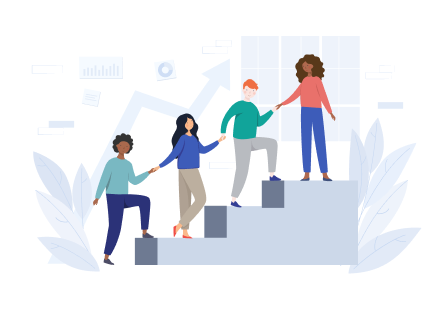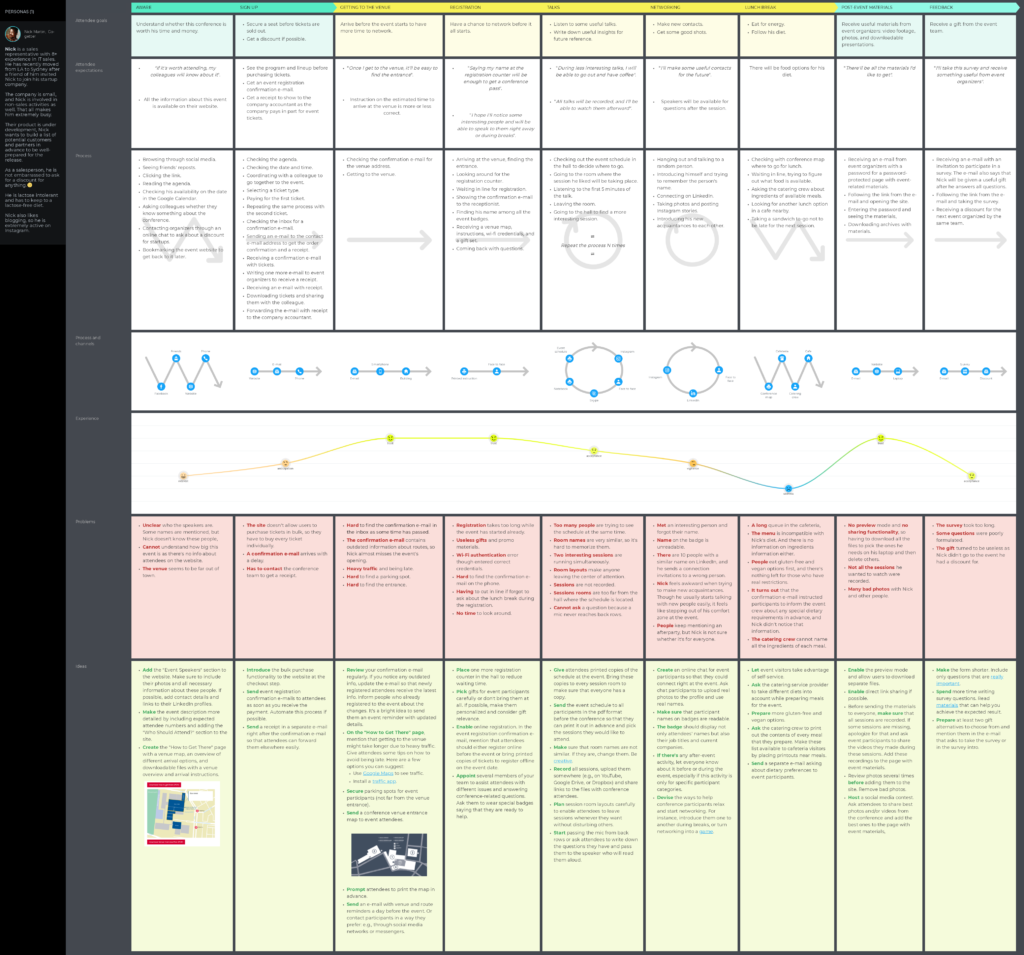The event attendee journey starts long before everyone is sitting on chairs and listening to keynotes. Suppose your goal is to create an awe-inspiring event and deliver an outstanding experience. In that case, focus on every single step of the event attendee journey: from receiving information about the thing to taking part in a post-event survey.
Building an event customer journey map helps to uncover problematic areas and highlight obstacles your attendees may encounter. Having such a map will not only help you understand how attendees interact with the event at different stages of the journey but also see the opportunities for improving their event attendee journey.
Let’s focus on some significant points for event mappers to consider.
Contents
Defining your event attendee journey personas first

It is reasonable to start your event attendee journey map by creating profiles of the attendee personas. The latter are groups of your target audience that represent certain patterns and can be approached from the same angle.
So, by analyzing your target audience, you can identify some groups of attendees based on some sort of criteria (e.g., demographics or behavior). Displaying all these peculiarities in event attendee persona profiles enables you to imagine yourself more vividly in these audience's shoes and empathize with them.
You may end up having 3-5 different personas that represent your target audience. Or there can be 20, 2, or any number of personas, and that's totally normal.
Having a bunch of persona profiles that are supposed to look (and feel) pretty much like those of real people, you can start looking at the journey they have with your and persona-related specifics. And then redesign or improve it, tailoring to the personas, or just fix the key pain points these personas have throughout the event.
Understanding the needs of your attendees determines what your event will be like. For instance, as a caring and people-centered event host, you will be able to consider your personas when:
- Looking for a perfect venue to run your event at;
- Explaining to participants how to get to the venue and arrange a transfer to the place;
- Deciding on the event communication channels for attendees' questions;
- Inviting speakers that people would be interested in listening to;
- Preparing gift packs with helpful items;
- Taking care of the attendees (e.g., by hiring a security team and medical brigade);
- Choosing the best time for the lunch break and setting up a dining room;
- Etc.
Identifying the stages your event participants take

It is better first to visualize and consider your event attendee journey stage by stage to gain an understanding of their entire experience.
Like other journeys, a customer journey for events is based on some sequence of steps.
Possible stages to consider during the attendee journey mapping:
- Finding out about it;
- Signing up for an event;
- Getting to a venue;
- Registering;
- Talking and networking;
- Having a spot of lunch;
- Receiving post-event materials;
- Giving feedback.
Having outlined the journey in general touches, you can delve into detail and describe the actions the attendee personas take at each stage. You may even divide your stages into substages. For example, Finding out about the event can be split into Hearing about the event and Researching while Getting to a venue can include Arriving, Parking, and Getting in substages.
Some things to consider
If you are working on a map for an event, there are some key things to pay attention to.
The significance of pre-event preparations
It can be tempting to concentrate on event attendance stages, but those that occur earlier (and later) are no less important.
Let's take the pre-event stages, for example. To take part in your events, potential attendee needs to somehow learn about it and register for it. So, you might either place your event on an event planning site like Eventbrite or create a landing page for it on your business website. Which one will work better for you? Check out your personas' profiles and then decide.
Also, if tickets are paid and you want to get payments via, say, PayPal, it might not be the best option for the attendee. And instead of implementing something that people won't love or use, be sure to include such important data in your persona profiles.
Then add it to a to-be map you are creating. This way, you will have all the crucial information in front of your eyes and be able to take advantage of it when planning and doing the whole thing.
Tailoring the event experiences to diverse attendee goals
Building separate event attendee journey maps around each of the attendee personas can reveal other crucial things to take into account.
Although all your attendees may do the same actions, such as signing up for your event and arriving at the venue, they may have different goals.
While some participants are attracted by recognizable speakers, others go to your event for productive networking.
And there can be people who just love coffee breaks and cookies. Say a hypothetical Steve, a sales manager, is going to meet some potential clients among other event attendees. Another one, Nicolas, who got recently promoted to the head of marketing, wants to see this job title on his participant badge and make new business contacts. In the end, both of them are expecting to get significant insights from the speakers.
You can also build a multi-persona journey map if you feel it works best in your case.
Drawing your attendee’s experience graph
When it comes to an as-is journey, pinpointing the participant’s emotional experience can be extremely handy. First of all, you may look at the map once and tell right away how your persona feels about their journey and your event or events.
The experience graph enables you to take an emotional journey of your customers and maybe tweak a few (or more) things to make their emotional attendee experience with you as smooth as possible. For instance, a friendly receptionist at the registration counter who is ready to assist attendees with different issues is a great way to evoke their trust and make them feel pleased or even maybe happy.
Besides, such a graph can help you reveal the most sensitive or unpleasant stages for your demanding attendees. For example, people who follow a specific diet will be disappointed to find no food options during the lunch break. For them, this little thing would be not the best experience.
Tracking the emotional state of your personas helps you alleviate your attendees’ discomfort with excellent service, detailed descriptions, and attention to detail, whether it is a personalized welcome gift or a clear venue map.
Packing your ideas into a meaningful event attendee journey
We've already listed general stages the attendee may take during their journey at some events. But there's more for you to consider when mapping their journey.
Collect all the channels your persona uses to learn more information about the event, contact your team, or leave feedback. Channels matter. Some people hate calls and want to have another option to solve their problem through. Some people prefer web forms instead of emails to share their thoughts. When all the channels are in front of your eyes coupled with identified issues, it's easier to understand what is missing and what has to be removed.
You may also use quotes from customer interviews and feedback to describe personas' throughs, expectations, and emotions. That increases empathy and makes it much more difficult to stay aside.
You may also add touchpoints to your map, make the journey even more visual with a storyboard, insert screenshots, photos of the venue, etc. But be careful: don't overload journey maps with the data you won't use and that is not really essential for your personas and attendee experience.
A ready-to-go event attendee journey template
Our new template, Conference Customer Journey Map, is a great starting point both for those who are trying their hand at mapping their attendees' journey and those who would like to iron out the wrinkles in their existing map.
The template describes the customer journey of a sales representative. This persona has recently moved from one country to another to join a startup company. He’s going to attend his first conference in a new country to network and tell industry peers about the upcoming product.
We considered all the steps the persona may go through in such a journey, captured their emotions, and identified channels, among other things. We also listed the possible problems and offered ways to fix those. So that's not just a template, but a collection of actionable ideas on how to improve the event journey. It's free and downloadable.
Wrapping up
In the world of events planning, where creating unforgettable and meaningful experiences for attendees is the ultimate goal, understanding the intricacies of the frictionless attendee journey is paramount. It's not just about what happens during the event itself; it's about the entire trajectory, from the initial spark of interest to the post-event reflections. By carefully mapping this journey, event organizers gain the power to identify pain points, enhance attendees' satisfaction, and ultimately craft events that leave a lasting impact. It's a journey of empathy, foresight, and constant improvement, and it's what sets exceptional events apart from the rest. So, as you embark on this journey of event experience design and attendee engagement, remember that the key to success lies in the details, the personas, the stages, and the emotional connections you create along the way.




A customer journey for events is still new for me. But your article helped me a looot. I’m currently working on an event attendee journey and would certainly add an experience graph to it. Thank you.